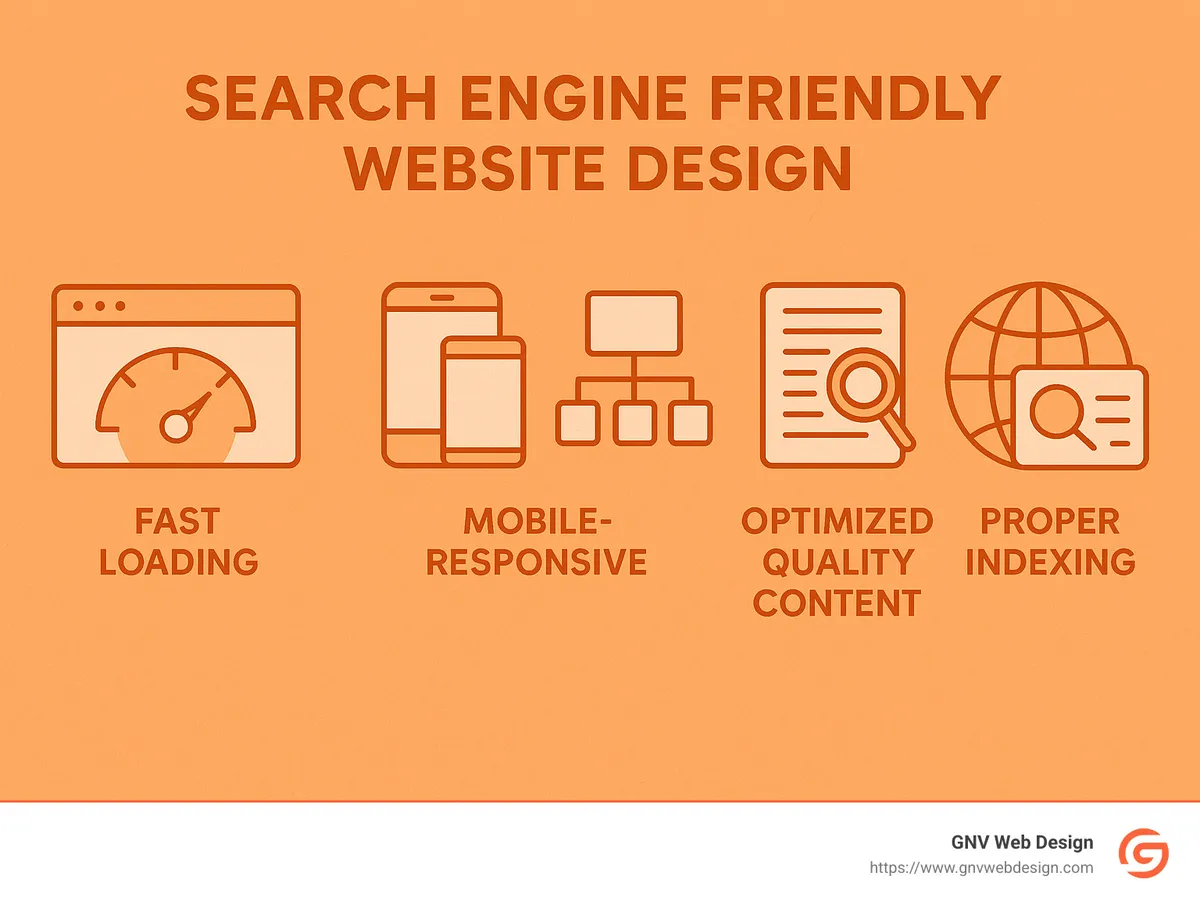Why Search Engine Friendly Website Design Matters for Your Business

Understanding Search Engine Friendly Website Design
Search engine friendly website design simply means creating websites that appeal equally to visitors and search engines like Google. Think of it as translating your website into a language that both humans and Google's clever little robots can easily understand.
At GNV Web Design, we've perfected this balancing act for countless businesses in Gainesville, Tampa, Jacksonville, and across Florida. After all, what's the use of having a stunning website if no one can actually find it, right?
Imagine search engines like librarians—very organized, meticulous librarians. They're constantly scanning websites, categorizing each page, and helping users quickly find exactly what they're searching for. An SEO-friendly site speaks clearly to these librarians, making their job easy while also providing a delightful experience for visitors.
According to the latest research on SEO-friendly website design, an effective SEO-friendly website combines three critical ingredients: technical soundness, an enjoyable user experience, and content custom to search intent.

When these three elements come together harmoniously, your website becomes irresistible—both to your target audience and to Google.
Why SEO Web Design Matters
You might be wondering: "Ok, sounds good, but why exactly should I care about SEO website design?"
First off, search engine friendly website design increases organic traffic. Ranking higher in Google search results means more visitors coming to your site without relying solely on paid ads. These visitors aren't random; they're people actively searching for the products or services you provide. That means they're more likely to convert into customers—good news for your bottom line!
But there's more. A thoughtfully designed SEO-friendly website also delivers a superior user experience. Visitors love sites that load quickly, look great on phones, and have clear, intuitive navigation. And when visitors enjoy your site, they're likely to stick around longer and return again later.
Plus, your website design directly impacts your brand's reputation. According to a survey by Top Design Firms, 50% of consumers believe a company's website design is crucial to their overall perception of the brand. A professional-looking, easy-to-find site builds trust and credibility—keys to turning browsers into customers.
Let's not forget cost-effectiveness. While paid ads require continuous investment, a well-designed, SEO-friendly website keeps delivering results over the long term, helping you reach new customers organically without ongoing expenses.
John Mueller from Google himself noted the importance of helpful, clear websites: "Linking to other websites is a great way to provide value to your users. Oftentimes, links help users to find out more, to check out your sources and to better understand how your content is relevant to the questions that they have."
Key Elements of Search Engine Friendly Website Design
Creating a website that both Google and your customers adore involves focusing on several key elements.
First, there's mobile-first design. With over 60% of all searches coming from mobile devices, catering to smartphone and tablet users isn't optional anymore—it's essential. Google now prioritizes mobile-friendly sites when ranking search results, thanks to their mobile-first indexing.
Website speed is equally important. Nobody enjoys waiting—as research from Unbounce shows, nearly 70% of consumers say page speed directly influences their decision to buy. Slow-loading pages frustrate visitors and send them bouncing back to Google's search results. Speeding up your website by compressing images, streamlining code, and using quality hosting pays off big-time.
Speaking of clarity, a clear site structure makes a huge difference. Organizing your pages logically with straightforward navigation helps both visitors and those Google "librarians" easily find their way around your site.
Of course, your website should also offer plenty of quality content—informative, relevant, and helpful material custom to your audience's questions. Applying Google's E-E-A-T principles (Experience, Expertise, Authoritativeness, and Trustworthiness) to your content builds credibility and boosts your rankings.
Let's not overlook the importance of proper technical implementation, either. Clean code, correctly used HTML tags, and structured data markup (also known as schema markup) help Google clearly interpret your site's content and context. Check out Ahrefs' guide on schema markup to see exactly how it works.
Security matters too. Websites using secure HTTPS connections not only rank higher in search results but also reassure visitors that their data is safe.
And don't forget about images! Optimizing images by compressing, resizing, and adding descriptive filenames and alt texts boosts your site's ranking potential and accessibility.
In short, remember this advice from Search Engine Land:
"Your website is the center of your digital marketing world. It's where you have the most control and where all digital marketing rivers run toward."
Investing in search engine friendly website design truly is one of the smartest decisions you can make for your business online.




